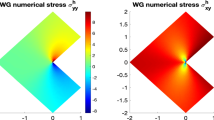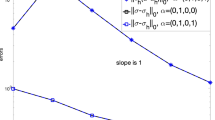Summary.
We consider a finite-element-in-space, and quadrature-in-time-discretization of a compressible linear quasistatic viscoelasticity problem. The spatial discretization uses a discontinous Galerkin finite element method based on polynomials of degree r—termed DG(r)—and the time discretization uses a trapezoidal-rectangle rule approximation to the Volterra (history) integral. Both semi- and fully-discrete a priori error estimates are derived without recourse to Gronwall's inequality, and therefore the error bounds do not show exponential growth in time. Moreover, the convergence rates are optimal in both h and r providing that the finite element space contains a globally continuous interpolant to the exact solution (e.g. when using the standard ℙk polynomial basis on simplicies, or tensor product polynomials, ℚk, on quadrilaterals). When this is not the case (e.g. using ℙk on quadri-laterals) the convergence rate is suboptimal in r but remains optimal in h. We also consider a reduction of the problem to standard linear elasticity where similarly optimal a priori error estimates are derived for the DG(r) approximation.
Similar content being viewed by others
References
Babuška, I., Suri, M.: The h-p version of the finite element method with quasiuniform meshes. Mathematical Modelling and Numerical Analysis, 21, 199–238 (1987)
Ferry, J. D.: Viscoelastic properties of polymers. John Wiley and Sons Inc., (1970)
Findley, W. N., Lai, J. S., Onaran, K.: Creep and relaxation of nonlinear viscoelastic materials (with an introduction to linear viscoelasticity). Applied Mathematics and Mechanics. North-Holland, 1976. Series eds. H. A. Lauwerier & W. T. Koiter
Friedrichs, K. O.: On the boundary-value problems of the theory of elasticity and Korn's inequality. Annals of Mathematics, 48, 267–297 (1947)
Golden, J. M., Graham, G. A. C.: Boundary value problems in linear viscoelasticity. Springer-Verlag, 1988
Horgan, C. O.: Korn's inequalities and their applications in continuum mechanics. SIAM Review, 37, 491–511 (1995)
Linz, P.: Analytical and numerical methods for Volterra equations. SIAM, Philadelphia, (1985)
Lockett, F. J.: Nonlinear viscoelastic solids. Academic Press, 1972
Oden, J. T., Babuška, I., Baumann, C. E.: A discontinuous hp finite element method for diffusion problems. J. Comput. Phys., 146, 491–519 (1998)
Rivière, B., Wheeler, M. F.: A discontinuous Galerkin method applied to nonlinear parabolic equations. Technical Report 99–26, TICAM, University of Texas at Austin, 1999. (see www.ticam.utexas.edu/reports/1999).
Rivière, B., Wheeler, M. F., Banas, K.: Discontinuous Galerkin method applied to a single phase flow in porous media. Part II. Computational Geosciences (to appear), 2000
Rivière, B., Wheeler, M. F., Girault, V.: Improved energy estimates for interior penalty, constrained and discontinuous Galerkin methods for elliptic problems. Part I. Computational Geosciences, 3, 337–360 (1999)
Schwab, Ch.: p- and hp-finite element methods. Numerical mathematics and scientific computation. Oxford University Press, 1998.
Shaw, S., Warby, M. K., Whiteman, J. R.: Numerical techniques for problems of quasistatic and dynamic viscoelasticity. In J. R. Whiteman, editor, The Mathematics of Finite Elements and Applications. mafelap 1993, pages 45–68. Wiley, Chichester, 1994.
Shaw, S., Warby, M. K., Whiteman, J. R.: Error estimates with sharp constants for a fading memory Volterra problem in linear solid viscoelasticity. SIAM J. Numer. Anal., 34, 1237–1254 (1997)
Shaw, S., Warby, M. K., Whiteman, J. R., Dawson, C., Wheeler, M. F.: Numerical techniques for the treatment of quasistatic viscoelastic stress problems in linear isotropic solids. Comput. Methods Appl. Mech. Engrg., 118, 211–237 (1994)
Shaw, S., Whiteman, J. R.: Numerical solution of linear quasistatic hereditary viscoelasticity problems. SIAM J. Numer. Anal, 38(1), 80–97 (2000)
Shaw, S., Whiteman, J. R.: Optimal long-time L p (0,T) data stability and semidiscrete error estimates for the Volterra formulation of the linear quasistatic viscoelasticity problem. Numer. Math., 88, 743–770 (2001). (BICOM Tech. Rep. 98/7 see: www.brunel.ac.uk/∼icsrbicm).
Wheeler, M. F.: An elliptic collocation-finite element method with interior penalties. SIAM J. Numer. Anal., 15, 152–161 (1978)
Author information
Authors and Affiliations
Corresponding author
Additional information
Mathematics Subject Classification (2000): 65N36
Shaw and Whiteman would like to acknowledge the support of the US Army Research Office, Grant #DAAD19-00-1-0421, and the UK EPSRC, Grant #GR/R10844/01. Whiteman would also like to acknowledge support from TICAM in the form of Visiting Research Fellowships.
Rights and permissions
About this article
Cite this article
Rivière, B., Shaw, S., Wheeler, M. et al. Discontinuous Galerkin finite element methods for linear elasticity and quasistatic linear viscoelasticity. Numer. Math. 95, 347–376 (2003). https://doi.org/10.1007/s002110200394
Received:
Revised:
Published:
Issue Date:
DOI: https://doi.org/10.1007/s002110200394




